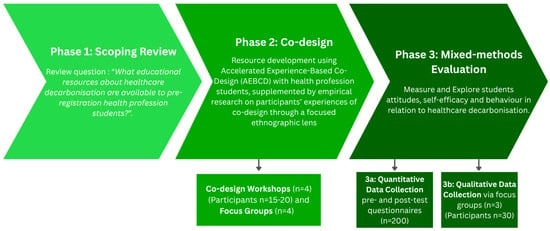- Study Protocol
Co-Design and Evaluation of a Gamified E-Resource About Healthcare Decarbonisation: A Study Protocol
- Nuala McLaughlin-Borlace,
- Stephanie Craig and
- Nuala Flood
- + 12 authors
Climate change poses a major global health threat, with healthcare systems contributing substantially to global greenhouse gas emissions. Health professionals and students play an essential role in advancing sustainable practice, yet many lack the knowledge, skills, and confidence needed to address the environmental impacts of healthcare. This study aims to co-design and evaluate a gamified e-resource that enhances pre-registration health profession students’ knowledge, self-efficacy, and attitudes towards healthcare decarbonisation, while encouraging sustainable behaviour change. A sequential explanatory design will be employed in three phases: (1) a scoping review of the literature; (2) four co-design workshops with students (n = 20) followed by post-workshop focus groups using focused ethnography to explore co-design experiences; and (3) pre- and post-test questionnaires (n = 200) assessing knowledge, attitudes, self-efficacy, behaviours, willingness to act, and usability, followed by focus groups (n = 30) exploring behavioural changes after using the e-resource. The study will generate evidence on how a co-designed, gamified e-resources influence student learning and engagement with healthcare decarbonisation. Findings will inform the integration of sustainability and decarbonisation principles within education and support efforts to equip future health professionals with the competencies required for a low-carbon healthcare system.
13 December 2025




